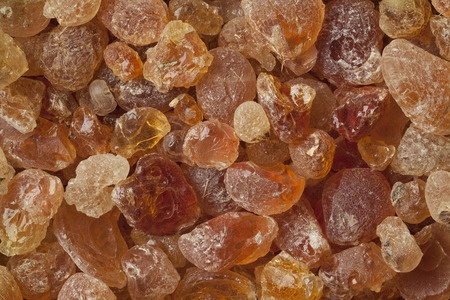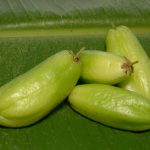
I suspect that when you look at an ingredient list on a beverage bottle you might wonder what gum Acacia or gum Arabic is doing in your drink. If it wasn’t there you would soon know about it! The colour might have fallen out of the product leaving a fluffy layer at the bottom of the bottle or there might be a strange ring at the top of the bottle. Whatever the case it all looks unsightly and indicates the product as being of low quality or simply abused. We might also detect some odd aromas too. Incidentally, this article will refer to it as gum Acacia simply for consistency.
Acacia gum is well known in the beverage industry as a carrier for all sorts of ingredients and its health benefits come from being a soluble fibre. It is the dried, edible exudate from a few Acacia species and ranges in colour from pale orange-brown through to a dark brown.
Cost wise it is an expensive ingredient and there is always a need to find alternatives. Part of the reason is the seasonal nature of its production and supply.
Sources
Acacia grows throughout Africa and India – and is a valuable cash source for growers in those areas. The ‘gum belt’ of sub-Saharan Africa includes the central and West African states of Chad, Eritrea, Kenya, Mali, Mauritania, Niger, Nigeria, Senegal, and both countries making up Sudan.
There are 600 species of acacia which belong to the Mimosacaea family (Family: Leguminosae), but only gum from Acacia senegal (L.), A. laeta and A. seyal are of any commercial significance. The main source is A. senegal which provides 80% of the world’s supply and the remaining 20% comes from the other two species. It’s worth noting that gum from A.laeta is becoming increasingly rare and may well disappear from the market.
Gum Acacia comes in different forms depending on the source. A. senegal produces ‘hard gum’ or ‘hashab gum’ whilst ‘flaky gum’ or ‘talha gum’ comes from the other species.
We also know it as gum Arabic or gum Acacia. The gum is extracted from the sap which exudes from the tree’s branches and trunk so it has a sustainability story too. The gum is primarily polysaccharide with about 1 to 3% being protein.
History Of Use
Gum Acacia has been used for a number of applications from the mists of time. The older term gum Arabic comes from European traders who bought the gum from cities such as Jeddah and Alexandria in Egypt. It had been widely used in ancient Egyptian culture. There are a number of examples from Egyptian tombs where the gum or ‘kami’ as it was known, was used as a base for pigment in hieroglyphs and to secure the bandages on Mummies.
The gum is also referenced in many holy books including the Torah and the Koran (Qu’ran). It is not entirely clear if it was ‘manna’ or part of the bread offered to the Israelites in the Bible.
Structure
It is mainly an arabinogalactan (90% by weight) but its functionality as an emulsifier comes from containing a small but significant amount of bound protein (1-3% w/w). There is other protein bound which is thought not to contribute any significant benefit. About 10% is described as the arabinogalactan protein fraction (AGP) and 1% is a glycoprotein fraction (GP) (Randall et al., 1988; Mahendran et al., 2008). Some lipid might be involved in emulsification too (Yadav et al., 2007a & b).
Product Development Opportunities
Gum Acacia is commonly used in both the food and pharmaceutical industry as a stabiliser, emulsifier and carrier for flavour and colour. It has been used in some cases as a thickener and hydrocolloid especially in low-calorie foods and health or dietetic beverages. Alternatives include other gums such as gum Tragacanth, pectins, xanthan gum, modified starch and cellulose derivatives.
It’s use as an emulsifier is well established having been used from the mid-19th Century. It is the ‘gold standard’ of emulsifiers (Randall et al., 1988). There is some difference in functionality especially depending on the source because of the variation in chemical structure.
A number of issues have to be considered when selecting the right gum Acacia for the job. Quality, source and availability, cost and ingredient interactions are all part of the mix when it comers to identifying the most appropriate gum. There are also many other different gums and stabilisers available which can be combined with gum Acacia to produce the best mix.
It has been combined with rice flours to create gluten-free bread and pastry type products. The gum helps bind flour particles in the dough which improves the workability of the rice flour (Shanthilal and Bhattacharya, 2015).
Encapsulation
Gum arabic is ideally suited to encapsulation and to edible coatings. Lipid-based materials especially volatile oils are readily protected by this gum because it fulfills the dual roles of a surface-active agent and a drying matrix. The gum can be partially replaced as an encapsulating agent using maltodextrins (DE 5.5-38) provided the gum arabic to oil ratio is just 1 w/w (McNamee et al., 2001). Better results for encapsulation are obtained using a ratio of 1:3 for lipid materials with good results (Soottitantawat et al., 2003; 2004; 2005).
Health Benefits
Soluble fibres generally have positive health benefits and gum Acacia is no different in this regard to other sources. It is thought soluble fibres reduce the absorption of fats and other materials from the intestine by physically holding these materials in the intestine. Soluble fibres also operate as prebiotic ingredients so acacia gum fits here too. In fact, it is commonly used in conjunction with other fibres in a products such as bars, cereals and beverages. The gum is known to be fermented in the colon (Phillips, 1998).
There are not enough clinical studies yet to demonstrate the sort of positive news that EFSA would welcome but initial studies suggest the following:
- It could reduce high cholesterol levels which was shown in a rat study but there are other pieces of evidence to support this benefit (Ali et al., 2009). Incidentally, another clinical study demonstrated that there is a high level of digestive tolerance to this gum – up to 50g per day because of the progressive fermentation pattern with moderate gas production.
- Fibre generally promotes good gut transition, absorption of nutrients and help with bowel movements. Alleviating constipation is one clear benefit and it can also stabilise diarrhoea.
- It might protect the liver from drug-induced damage. Again a similar study in mice showed that when they were fed acacia fibre, it helped to protect their livers from the drug acetoaminophen which they had been fed earlier and is quite toxic to them as it would be to us if we overdosed. The possible mechanism of protection could be a reduction in oxidative stress (Gamal el-Din et al., 2003).
- It could ameliorate diabetes and reduce kidney damage that develops. In a diabetic mouse study, acacia fibre helped to lower arterial blood pressure which would help those patients suffering diabetic nephropathy i.e. a form of kidney damage. It would be suitable as a supplement for kidney dialysis patients.
- Reduces the impact of irritable bowel syndrome (Rochat et al., 2006).
- Acts as a prebiotic by allowing probiotic bacteria and other flora/fauna to grow.
- Acts as a throat soother in some syrups – coating food with a viscous agent helps with swallowing and it has been tried for cancer sufferers with dry mouth for example.
Regulations And Toxicity
The gum has GRAS status in the USA. There is a not a lot of evidence to suggest it is toxic unless the supply chain is poorly managed. The more likely issues come from dust inhalation and it can cause itchiness simply because of its form.
There is a very educational web-site (WebMD) on the health benefits of the gum. There is also an extremely comprehensive book covering off the subject (Williams and Phillips, 2009).
Suppliers
References
Ali, B.H., Ziada, A., Blunden, G. (2009) Biological effects of gum arabic: a review of some recent research. Food Chem. Toxicol. 47(1) pp. 1-8.
Gamal el-Din, A.M, Mostafa, A.M., Al-Shabanah, O.A., Al-Bekairi, A.M., Nagi, M.N. (2003) Protective effect of arabic gum against acetaminophen-induced hepatotoxicity in mice. Pharmacol. Res. 48(6) pp. 631-5
, , , , . (2008) New insights into the structural characteristics of the arabinogalactan-protein (AGP) fraction of gum arabic. J. Agric. Food Chem. 56(19) pp. 9269–76.
McNamee, B.F., O’Riordan, E.D. & O’Sullivan, M. (2001). Effect of partial replacement of gum arabic with carbohydrates on its emulsification properties. Journal of Agricultural and Food Chemistry, 49, pp. 3385–3388 .
Nasir, O., Umbach, A.T., Rexhepaj, R., Ackermann, T.F., Bhandaru, M., Ebrahim, A., Artunc, F., Kempe, D.S., Puchchakayala, G, Siraskar, B., Föller, M., Saeed, A., Lang, F. (2012) Effects of gum arabic (Acacia senegal) on renal function in diabetic mice. Kidney Blood Press Res. 35(5) pp. 365-72.
Phillips, G. O. (1998). Acacia gum (gum arabic): a nutritional fibre; metabolism and calorific value. Food Additives & Contaminants, 15(3), pp. 251-264
, , . (1988) The role of the proteinaceous component on the emulsifying properties of gum arabic. Food Hydrocoll. 2(2) pp. 131–40.
Reiner, S.J., Reineccius, G.A. and Peppard, T.L. (2010), A Comparison of the Stability of Beverage Cloud Emulsions Formulated with Different Gum Acacia- and Starch-Based Emulsifiers. Journal of Food Science, 75: E236–E246. doi:10.1111/j.1750-3841.2010.01625.x
Rochat, F., Ballevre, O., & Jann, A. (2006). U.S. Patent No. 7,141,554. Washington, DC: U.S. Patent and Trademark Office.
Shanthilal, J. and Bhattacharya, S. (2015) Rheology of Rice Flour Dough with Gum Arabic: Small and Large-Deformation Studies, Sensory Assessment and Modeling. Journal of Food Science, 80: E1735–E1745. doi:10.1111/1750-3841.12941
Soottitantawat, A., Yoshii, H., Furuta, T. et al. (2004). Effect of water activity on the release characteristics and oxidative stability of d-limonene encapsulated by spray drying. Journal of Agricultural and Food Chemistry, 52, pp. 1269–1276
Soottitantawat, A., Bigeard, F., Yoshii, H., Furuta, T., Ohkawara, M. & Linko, P. (2005). Influence of emulsion and powder size on the stability of encapsulated d-limonene by spray-drying. Innovative Food Science and Emerging Technologies, 6, pp. 107–114
, , , , . (2007a) Corn fiber gum: a potential gum arabic replacer for beverage flavor emulsification. Food Hydrocoll. 21(7) pp. 1022–30.
, , , . (2007b) Chemical investigation of the structural basis of the emulsifying activity of gum arabic. Food Hydrocoll. 21(2) pp. 297–308

Nice piece of work for an essay which is what I did it. Had to rewrite it a bit but it had all the key facts for me. Thx.